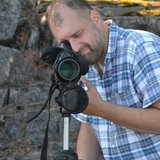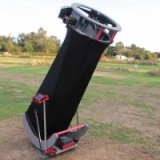×
INDI Library v2.0.7 is Released (01 Apr 2024)
Bi-monthly release with minor bug fixes and improvements
Driver for Raspberry Pi "High Quality Camera?"
- Lars Berntzon
-

- Offline
- Senior Member
-

- Posts: 49
- Thank you received: 12
Replied by Lars Berntzon on topic Driver for Raspberry Pi "High Quality Camera?"
Ill take back that. I cant get more than 1 sec exposure without first taking a 20 sec exposure for the camera to kind of synchronize. As I understand the camera is then measuring and adjusting settings. There must be a way to set all values fixed, still looking for that.
The following user(s) said Thank You: Keith Venables
3 years 3 months ago
#65211
The topic has been locked.
- Jasem Mutlaq
-

- Away
- Administrator
-

Replied by Jasem Mutlaq on topic Driver for Raspberry Pi "High Quality Camera?"
Ok, let me know if I can help in anyway.
3 years 3 months ago
#65212
The topic has been locked.
- Keith Venables
-

- Offline
- New Member
-

- Posts: 12
- Thank you received: 1
Replied by Keith Venables on topic Driver for Raspberry Pi "High Quality Camera?"
Hi,
Just joined the forum. I'm an experienced visual astronomer and now retired I'm exploring using CCD's to help.
I like raspberry Pi's and have used them quite a bit, but wouldnt consider myself a capable user/programmer.
first project was an all sky camera. A QHY CCD connected to the a remote RPi4 running IndigoSky. Worked out nicely in the end although the QHY 5L is a temperamental beast.
Now I'm trying to make an electronic finder for my Dobsonian.
The RPi HQ Camera looked interesting and I believe others have managed to get sufficient sensitivity to capture stars and plate solve the image.
First step I thought would be to use Astroberry/Kstars/Indi to test the setup and prove the concept. The I would attempt to write a more dedicated programme to do the capture/plate solving/scope drive.
Steep learning curve but I'm getting there.
problem I've hit is exposure & gain control. it seems not to change. I've read this thread and tried various things but to no avail.
When I start Ekos from Kstars, I get an Indi control panel pop up. On the tabs I can set exposure time and gain. I then go to the 'capture' tab in Ekos. Again I am presented with options to change exposure and gain. But they dont reflect what I may have set on the Indi control panel.
I've tried various combos of changing gain and exposure in various orders, but the resulting image always appears the same. The activity monitor script at the bottom of the window suggest the right length exposures are being taken, but the displayed images never change.
Any help greatly appreciated. (please remember I'm not a programmer!)
Just joined the forum. I'm an experienced visual astronomer and now retired I'm exploring using CCD's to help.
I like raspberry Pi's and have used them quite a bit, but wouldnt consider myself a capable user/programmer.
first project was an all sky camera. A QHY CCD connected to the a remote RPi4 running IndigoSky. Worked out nicely in the end although the QHY 5L is a temperamental beast.
Now I'm trying to make an electronic finder for my Dobsonian.
The RPi HQ Camera looked interesting and I believe others have managed to get sufficient sensitivity to capture stars and plate solve the image.
First step I thought would be to use Astroberry/Kstars/Indi to test the setup and prove the concept. The I would attempt to write a more dedicated programme to do the capture/plate solving/scope drive.
Steep learning curve but I'm getting there.
problem I've hit is exposure & gain control. it seems not to change. I've read this thread and tried various things but to no avail.
When I start Ekos from Kstars, I get an Indi control panel pop up. On the tabs I can set exposure time and gain. I then go to the 'capture' tab in Ekos. Again I am presented with options to change exposure and gain. But they dont reflect what I may have set on the Indi control panel.
I've tried various combos of changing gain and exposure in various orders, but the resulting image always appears the same. The activity monitor script at the bottom of the window suggest the right length exposures are being taken, but the displayed images never change.
Any help greatly appreciated. (please remember I'm not a programmer!)
3 years 3 months ago
#65582
The topic has been locked.
- Keith Venables
-

- Offline
- New Member
-

- Posts: 12
- Thank you received: 1
Replied by Keith Venables on topic Driver for Raspberry Pi "High Quality Camera?"
Hi,
Just joined the forum after looking for solutions to problems I am having with my RPI HQ Camera and Kstars/Ekos/Indi.
Grateful for all the good work in this thread. It has helped quite a lot, but i am still not sure I am in control of exposure time - it seems most of the time I am trying things in the dark, (sorry no pun intended).
I'll keep following the thread, but if there is any thing I can do by way of testing etc? ps: i'm not a programmer!!
Just joined the forum after looking for solutions to problems I am having with my RPI HQ Camera and Kstars/Ekos/Indi.
Grateful for all the good work in this thread. It has helped quite a lot, but i am still not sure I am in control of exposure time - it seems most of the time I am trying things in the dark, (sorry no pun intended).
I'll keep following the thread, but if there is any thing I can do by way of testing etc? ps: i'm not a programmer!!
3 years 3 months ago
#65588
The topic has been locked.
- Keith Venables
-

- Offline
- New Member
-

- Posts: 12
- Thank you received: 1
Replied by Keith Venables on topic Driver for Raspberry Pi "High Quality Camera?"
Hi,
I've been stuck on this issue for a couple of weeks now. Just once I managed to get long exposures, but do not seem to reliably get it to work.
I have an RPi HQ camera on a RPi4 4GB, running astroberry 2.0.3. I did a fresh install a couple of days ago, to no avail.
Camera works OK with long exposures from the command line.
So far best way seems to be
Start up Kstars/Ekos & select profile
Set gain to anything other than the default '--" (dont seem to be able to change this default)
Try & do a long exposure - it will ignore the value and do a 1 second exposure first time
Thereafter it seems to respond to long exposure request
I'm hopeful for a solution, and in the meantime if I can help with any testing (I'm retired!) to try and pin down any issues I'd be more than happy.
Best regards
Keith
I've been stuck on this issue for a couple of weeks now. Just once I managed to get long exposures, but do not seem to reliably get it to work.
I have an RPi HQ camera on a RPi4 4GB, running astroberry 2.0.3. I did a fresh install a couple of days ago, to no avail.
Camera works OK with long exposures from the command line.
So far best way seems to be
Start up Kstars/Ekos & select profile
Set gain to anything other than the default '--" (dont seem to be able to change this default)
Try & do a long exposure - it will ignore the value and do a 1 second exposure first time
Thereafter it seems to respond to long exposure request
I'm hopeful for a solution, and in the meantime if I can help with any testing (I'm retired!) to try and pin down any issues I'd be more than happy.
Best regards
Keith
The topic has been locked.
- Lars Berntzon
-

- Offline
- Senior Member
-

- Posts: 49
- Thank you received: 12
Replied by Lars Berntzon on topic Driver for Raspberry Pi "High Quality Camera?"
I know about the problem and it is very annoying, sometimes I can get long exposures very reproducible. Probably we only need to figure out how to set the correct sensor-mode for the HiQ camera, but I have not found such documentation. Ive sent request to Sony about their sensor, but no reply. Berhaps I should ask Broadcom instead ..
3 years 3 months ago
#66394
The topic has been locked.
- Keith Venables
-

- Offline
- New Member
-

- Posts: 12
- Thank you received: 1
Replied by Keith Venables on topic Driver for Raspberry Pi "High Quality Camera?"
I've found the following command line always works ok, first time, any time. Somethingabout First Mode seems rekey perhaps?
raspistill -t 1 -md 3 -bm -ex off -ag 1 --shutter 200000 -ISO 800 -st -o /home/astroberry/Desktop/long.jpg
raspistill -t 1 -md 3 -bm -ex off -ag 1 --shutter 200000 -ISO 800 -st -o /home/astroberry/Desktop/long.jpg
3 years 3 months ago
#66423
The topic has been locked.
- Lars Berntzon
-

- Offline
- Senior Member
-

- Posts: 49
- Thank you received: 12
Replied by Lars Berntzon on topic Driver for Raspberry Pi "High Quality Camera?"
Yes, mode is the key probably. QRainman has provided me with lot of information so Ill update the code from this.
3 years 3 months ago
#66425
The topic has been locked.
- Keith Venables
-

- Offline
- New Member
-

- Posts: 12
- Thank you received: 1
Replied by Keith Venables on topic Driver for Raspberry Pi "High Quality Camera?"
OOps typo & autocorrect - meant to be "Burst Mode"!
3 years 3 months ago
#66426
The topic has been locked.
- Lars Berntzon
-

- Offline
- Senior Member
-

- Posts: 49
- Thank you received: 12
Replied by Lars Berntzon on topic Driver for Raspberry Pi "High Quality Camera?"
Oh, ok. That was interesting for sure. Ill see if I can find anything there.
Thanks, Lars
Thanks, Lars
3 years 3 months ago
#66429
The topic has been locked.
- Lars Berntzon
-

- Offline
- Senior Member
-

- Posts: 49
- Thank you received: 12
Replied by Lars Berntzon on topic Driver for Raspberry Pi "High Quality Camera?"
Ok, done some testing today. Neither burst mode or hard setting a mode seems to help. Also I see that when I use raspistill to get a 5 s exposure it can take up to 45 seconds. That is really strange I think.
3 years 3 months ago
#66444
The topic has been locked.
Replied by J. Hill on topic Driver for Raspberry Pi "High Quality Camera?"
Yeah. That one had me stumped for a while. Seems that raspistill will go through several frames (around 7 of them) before it presents the final frame to the user. Each frame is the length of the exposure time that has been set. That is the very reason for implementing raspiraw in my driver after attempting to use raspistill.
3 years 3 months ago
#66454
The topic has been locked.
Time to create page: 0.475 seconds
© 2003-2022 by INDI Library. All rights reserved.
